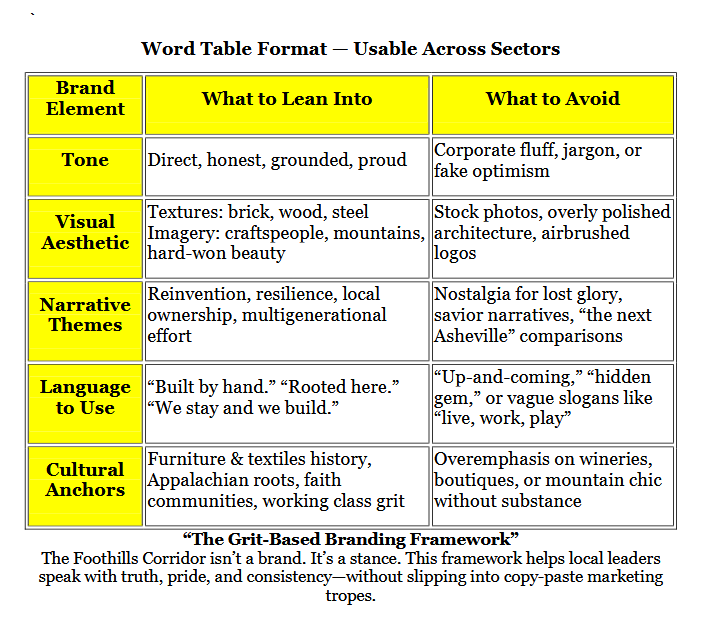Part VI - the Narrative & Chapter 22: Branding the Corridor
Part VI: Rewriting the Regional Narrative -
The Power of Telling the Truth—and Owning the Future
The Foothills Corridor has long been misunderstood—by outsiders, by media, and sometimes even by itself. Branded as past tense. Talked about as if decline were destiny. Seen through the lens of what left, not what’s being built.
But regions don’t rise on policy alone. They rise when the story changes—when people start to see themselves not as remnants of a broken economy, but as agents of a new one.
This chapter is about that change. About reclaiming the narrative. About refusing to be defined by poverty stats, job losses, or outdated stereotypes. And about replacing those fragments with a story that reflects resilience, ingenuity, and hard-earned transformation.
Because in the end, what a place believes about itself shapes what it’s willing to fight for. It’s time the Foothills believed something different.
Not just that revival is possible — But that it’s already happening. And that we are the ones rewriting the story.
Chapter 22: Branding the Corridor: Grit, Not Gloss
The Foothills Corridor doesn’t need a slick rebrand—it needs a story that reflects its truth. For too long, the narrative around this region has been shaped by outsiders: developers pitching lifestyle fantasy, politicians romanticizing the past, or marketers slapping on slogans that sound nice but say nothing.
It’s time to take the mic back. And when we do, the voice that emerges should be unmistakable: gritty, grounded, and proud.
The Problem with Gloss
Traditional place-branding campaigns tend to emphasize surface-level appeal: pretty pictures, upbeat slogans, curated testimonials. But in the Foothills, that kind of gloss doesn’t just miss the mark—it breeds mistrust.
Why?
· Residents know when they’re being sold something that doesn’t match reality.
· Shiny marketing doesn’t square with closed mills, struggling schools, or hollowed-out downtowns.
· It often alienates the very people it claims to represent.
Communities that have been through hard things don’t want spin. They want a brand that tells the truth—and builds pride around survival, reinvention, and substance.
What Grit Looks Like
A gritty regional brand doesn’t shy away from hard history. It owns it—and points to what’s rising from it.
It says:
· We know what collapse looks like. And we’re still here.
· We don’t chase hype. We build what lasts.
· We’re not trying to be the next anything. We’re building the first of something.
This kind of branding speaks directly to:
· Young people who want to stay or come back to something real.
· Entrepreneurs and creatives looking for authenticity, not artifice.
· Funders and partners who value character over flash.
Elements of a True Regional Identity
To move beyond empty slogans, the Corridor’s brand should include:
· Visual language rooted in local texture—wood, brick, farmland, trail.
· Tone of voice that is plainspoken, confident, and unpolished.
· Cultural signals like work ethic, multigenerational ties, storytelling.
· Economic realism that doesn’t overpromise, but does overdeliver.
Examples of branding statements that might resonate:
· "Built with both hands."
· "Where work still means something."
· "Hard roots. Strong future."
· "Grit is our growth strategy."
The goal isn’t just to attract visitors or investors. It’s to help residents recognize themselves in the story—and feel proud to share it.
Beyond the Logo: Living the Brand
Branding isn’t what you say—it’s what you do. The most powerful brand is built by consistency across experience:
· Are downtown spaces walkable and welcoming?
· Do youth programs reflect the values we talk about?
· Are job training programs accessible and relevant?
· Is local government transparent and responsive?
If the answer is yes, then the brand writes itself.
Why It Matters
Narrative control is power. And for a region like the Foothills—so often written off or reduced to caricature—owning the story is the first step in owning the future.
Grit isn’t about glorifying struggle. It’s about honoring truth and turning it into momentum. A brand isn’t invented in a boardroom—it’s built through the reality of hard work and the determination to succeed.
Because real communities don’t need polish. They need to be seen. They need to be believed. And the best way to start is by telling the truth—loud, clear, and unapologetically local.


